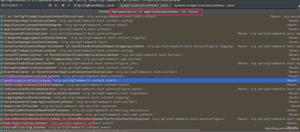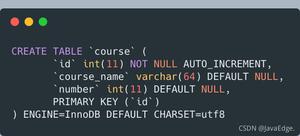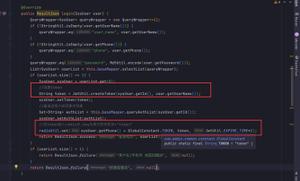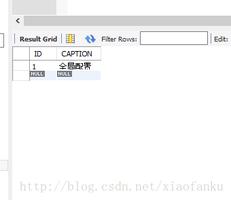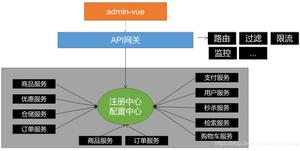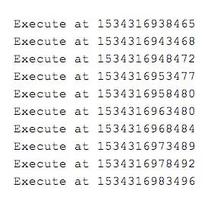(十二) Spring 中的事件处理
本文内容纲要:
- 1、简介- 2、监听上下文事件
- 3、Spring 中的自定义事件
(十二) Spring 中的事件处理
1、简介
你已经看到了在所有章节中 Spring 的核心是 ApplicationContext,它负责管理 beans 的完整生命周期。当加载 beans 时,ApplicationContext 发布某些类型的事件。例如,当上下文启动时,ContextStartedEvent 发布,当上下文停止时,ContextStoppedEvent 发布。
通过 ApplicationEvent 类 和 ApplicationListener 接口 来提供在 ApplicationContext 中处理事件。如果一个 bean 实现 ApplicationListener,那么每次 ApplicationEvent 被发布到 ApplicationContext 上,那个 bean 会被通知。
Spring 提供了以下的标准事件:
| 序号 | Spring 内置事件 & 描述 |
|---|---|
| 1 | ContextRefreshedEvent ApplicationContext 被初始化或刷新时,该事件被发布。这也可以在 ConfigurableApplicationContext 接口中使用 refresh() 方法来发生。 |
| 2 | ContextStartedEvent 当使用 ConfigurableApplicationContext 接口中的 start() 方法启动 ApplicationContext 时,该事件被发布。你可以调查你的数据库,或者你可以在接受到这个事件后重启任何停止的应用程序。 |
| 3 | ContextStoppedEvent 当使用 ConfigurableApplicationContext 接口中的 stop() 方法停止 ApplicationContext 时,发布这个事件。你可以在接受到这个事件后做必要的清理的工作。 |
| 4 | ContextClosedEvent 当使用 ConfigurableApplicationContext 接口中的 close() 方法关闭 ApplicationContext 时,该事件被发布。一个已关闭的上下文到达生命周期末端;它不能被刷新或重启。 |
| 5 | RequestHandledEvent 这是一个 web-specific 事件,告诉所有 bean HTTP 请求已经被服务。 |
由于 Spring 的事件处理是单线程的,所以如果一个事件被发布,直至并且除非所有的接收者得到的该消息,该进程被阻塞并且流程将不会继续。因此,如果事件处理被使用,在设计应用程序时应注意。
2、监听上下文事件
为了监听上下文事件,一个 bean 应该实现只有一个方法 onApplicationEvent() 的 ApplicationListener 接口。因此,我们写一个例子来看看事件是如何传播的,以及如何可以用代码来执行基于某些事件所需的任务。
HelloWorld文件的内容:
public class HelloWorld { private String message;
public void setMessage(String message){
this.message = message;
}
public void getMessage(){
System.out.println("Your Message : " + message);
}
}
下面是 CStartEventHandler.java 文件的内容:
import org.springframework.context.ApplicationListener;import org.springframework.context.event.ContextStartedEvent;
public class CStartEventHandler implements ApplicationListener<ContextStartedEvent>{
public void onApplicationEvent(ContextStartedEvent event) {
System.out.println("ContextStartedEvent Received");
}
}
下面是 CStopEventHandler.java 文件的内容:
import org.springframework.context.ApplicationListener;import org.springframework.context.event.ContextStoppedEvent;
public class CStopEventHandler implements ApplicationListener<ContextStoppedEvent>{
public void onApplicationEvent(ContextStoppedEvent event) {
System.out.println("ContextStoppedEvent Received");
}
}
下面是 MainApp.java 文件的内容:
import org.springframework.context.ConfigurableApplicationContext;import org.springframework.context.support.ClassPathXmlApplicationContext;
public class MainApp {
public static void main(String[] args) {
ConfigurableApplicationContext context = new ClassPathXmlApplicationContext("Beans.xml");
// Let us raise a start event.
context.start();
HelloWorld obj = (HelloWorld) context.getBean("helloWorld");
obj.getMessage();
// Let us raise a stop event.
context.stop();
}
}
下面是配置文件 Beans.xml 文件:
<?xml version="1.0" encoding="UTF-8"?><beans xmlns="http://www.springframework.org/schema/beans"
xmlns:xsi="http://www.w3.org/2001/XMLSchema-instance"
xsi:schemaLocation="http://www.springframework.org/schema/beans
http://www.springframework.org/schema/beans/spring-beans-3.0.xsd">
<bean id="helloWorld" class="com.dw.study.HelloWorld">
<property name="message" value="Hello World!"/>
</bean>
<bean id="cStartEventHandler" class="com.tutorialspoint.CStartEventHandler"/>
<bean id="cStopEventHandler" class="com.tutorialspoint.CStopEventHandler"/>
</beans>
3、Spring 中的自定义事件
这个是 CustomEvent.java 文件的内容:
import org.springframework.context.ApplicationEvent;public class CustomEvent extends ApplicationEvent{
public CustomEvent(Object source) {
super(source);
}
public String toString(){
return "My Custom Event";
}
}
下面是 CustomEventPublisher.java 文件的内容:
import org.springframework.context.ApplicationEventPublisher;import org.springframework.context.ApplicationEventPublisherAware;
public class CustomEventPublisher implements ApplicationEventPublisherAware {
private ApplicationEventPublisher publisher;
public void setApplicationEventPublisher(ApplicationEventPublisher publisher) {
this.publisher = publisher;
}
public void publish() {
CustomEvent ce = new CustomEvent(this);
publisher.publishEvent(ce);
}
}
下面是 CustomEventHandler.java 文件的内容:
import org.springframework.context.ApplicationListener;public class CustomEventHandler implements ApplicationListener<CustomEvent>{
public void onApplicationEvent(CustomEvent event) {
System.out.println(event.toString());
}
}
下面是 MainApp.java 文件的内容:
import org.springframework.context.ConfigurableApplicationContext;import org.springframework.context.support.ClassPathXmlApplicationContext;
public class MainApp {
public static void main(String[] args) {
ConfigurableApplicationContext context = new ClassPathXmlApplicationContext("Beans.xml");
CustomEventPublisher cvp = (CustomEventPublisher) context.getBean("customEventPublisher");
cvp.publish();
cvp.publish();
}
}
下面是配置文件 Beans.xml:
<?xml version="1.0" encoding="UTF-8"?><beans xmlns="http://www.springframework.org/schema/beans"
xmlns:xsi="http://www.w3.org/2001/XMLSchema-instance"
xsi:schemaLocation="http://www.springframework.org/schema/beans
http://www.springframework.org/schema/beans/spring-beans-3.0.xsd">
<bean id="customEventHandler" class="com.tutorialspoint.CustomEventHandler"/>
<bean id="customEventPublisher" class="com.tutorialspoint.CustomEventPublisher"/>
</beans>
运行该应用程序,将输出以下信息:
My Custom EventMy Custom Event
本文内容总结:1、简介,2、监听上下文事件,3、Spring 中的自定义事件,
原文链接:https://www.cnblogs.com/dw3306/p/15073057.html
以上是 (十二) Spring 中的事件处理 的全部内容, 来源链接: utcz.com/z/296514.html

